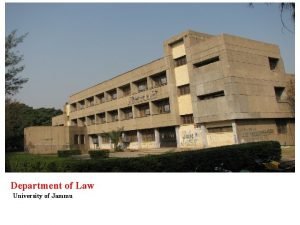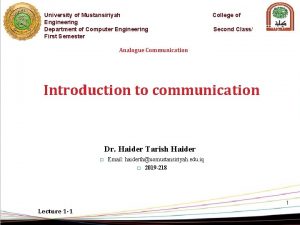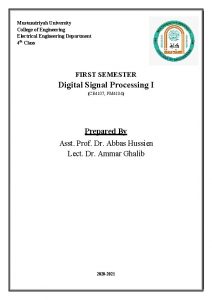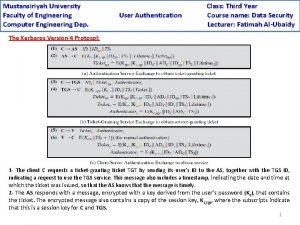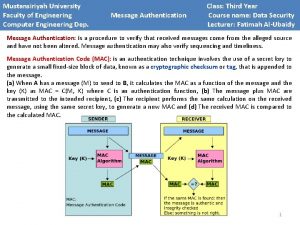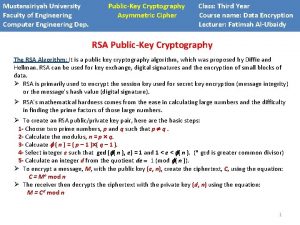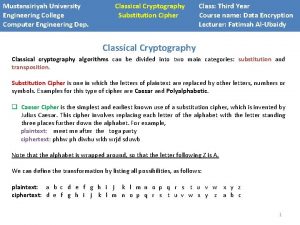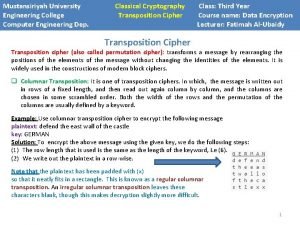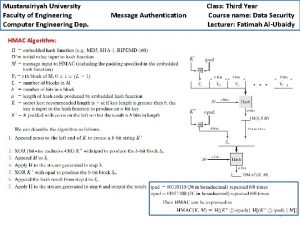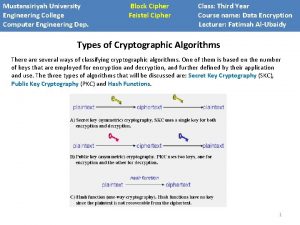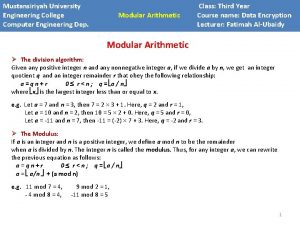University of Mustansiriyah Engineering Department of Computer Engineering


















- Slides: 18

University of Mustansiriyah Engineering Department of Computer Engineering First Semester College of Second Class/ Analogue Communication Signal Analysis & Definition of modulation Dr. Haider Tarish Haider � Lecture 1 -2 Email: haiderth@uomustansiriyah. edu. iq � 2019 -218 1

Signal Analysis & Definition of modulation Signal Analysis The signals can be classified into the following types: Deterministic and Random: which can be expressed mathematically as a function of time (f(t)=t 2 ) other signals is random or noise signals. Periodic and Non periodic (Aperiodic): which can be repeated itself after a fixed length of time (i. e. f(t)=f(t+T), for -∞< t< ∞). Periodic function Non periodic function Lecture 1 -2 2

Signal Analysis & Definition of modulation Examples of Signals 1 - Impules (Dirac): 2 -Unite Step: Lecture 1 -2 3

Signal Analysis & Definition of modulation 3 -Signum function Lecture 1 -2 4

Signal Analysis & Definition of modulation Spectrum of sinusoidal signal. f(t)=A cos(w 0 t+ ), we can write Single side spectrum -Two side spectrum Lecture 1 -2 5

Signal Analysis & Definition of modulation A Method of Translation: A signal may be translated to a new spectral range be multiplying the signal with an auxiliary sinusoidal wave form. Let the signal be a sinusoidal waveform Lecture 1 -2 6

Signal Analysis & Definition of modulation , Am = constant amplitude, Am/2 fm -fm f/Hz Two-side spectrum Am fm Lecture 1 -2 f/Hz Single-Side spectrum 7

Signal Analysis & Definition of modulation Consider the auxiliary signal. Ac = constant amplitude fc= frequency Multiplication of vm(t) and vc(t) will result in vm(t) vc(t)= (Am coswmt) (Ac coswct) The amplitude spectrum of the product is -(fc+fm) Lecture 1 -2 -fc -(fc-fm) fc-fm fc fc+fm 8

Signal Analysis & Definition of modulation Note: It may be seen that the original spectral lines have been translated both in the positive and negative frequency direction by the amount fc. The message signal of finite energy and non- periodic, it may be represented in freq. domain by its Fourier Transform. Let the signal m(t) be band limited to the freq. range zero to wm its Fourier Transform M(w) is as shown. The spectrum resulting when m(t) is multiplied by (Ac=1) Bw=wm Is F(m(t) cos wct)= -wm Lecture 1 -2 0 wm 9

Signal Analysis & Definition of modulation F(m(t)coswct) Bw=2 wm -wc-wm -wc+wm wc-wm wc wc+wm USB- upper side band Spectral components above the auxiliary signal (wc wc + wm) LSB- lower sideband Spectral components below the auxiliary signal (wc- wm wc) Lecture 1 -2 10

Signal Analysis & Definition of modulation Elements of a Communication System Source i/p transducer i/p message i/p signal Transmitter Communication channel Transmitted signal Receiver Receive signal O/P transducer i/p signal Destination i/p message noise Source: information sources such as human voice, machine of message, TV, or data. Transducer: The input transducer converts the message to (a signal) an electric signal (voltage or current). Similarly; the O/P transducer at the destination converts the O/P signal to the appropriate message form. Transmitter: The transmitter coupled i/p massage signal to the channel for effective and efficient transformation. Several signal processing operation may be perform by the transmitter such as amplification filtering and modulation. Lecture 1 -2 11

Signal Analysis & Definition of modulation Modulation: it's a process design to match the properties of the transmitted signal to the channel. Transmission channel: The channel provides the electrical connection between the information source and the user (receiver). The channel may have different forms. Wires or cables: telephone lines, power lines, Space (wireless). Optical fiber. Water. Earth. ü • • • Regard less of channel type; it degrades the transmitted signal in a number of ways. Attenuation: reduction of signal strength with distance. Distortion: signal alteration due to imperfect channel response. Interference: contamination by extraneous signals of a form similar to the desired signal • Noise: Random and unpredictable electric signal form natural causes both internal and external to the system. Lecture 1 -2 12

Signal Analysis & Definition of modulation Receiver: The function of the receiver is to extract the desired signal from the degraded version of the transmitted signal coming from the channel this is performed through the process of demodulations. Signal- to-Noise Ratio (SNR): The ratio of the signal power (S) to the noise power (N). Bandwidth (B): is the frequency range occupied by a modulated carrier signal Types of Communication Systems: Communication system can be divided in the three categories, based on the type of modulation used and the nature of the information source: q Analog communication systems. q Digital communication systems. q Hybrid communication systems. Lecture 1 -2 13

Signal Analysis & Definition of modulation Analog signal transmission: For purpose of analysis analog signal transmission defines the transmission of: arbitrary, finite energy low pass signals over a given channel. In some cases, the signal will be a single sinusoidal tone or power signal. f(t)= coswmt Low- pass channel: baseband communication need Band pass channel: broad band comm Modulation Note: The majority of practical channels have band pass characteristics and modulation is necessary for translating the low pass signal spectrum to match the band pass channel c/c. Lecture 1 -2 14

Signal Analysis & Definition of modulation Type of modulation: According to carrier wave: 1 - Continuous Wave (CW) modulation: The carrier is a sinusoidal wave form at a freq. much higher than any of the freq. components continue in the modulating signal (the amplitude, frequency, phase or combination) is altered of the carrier in accordions with the information to be transmitted. Amplitude modulation: AM, Double-Side Band (DSB), Single Side Band SSB, etc. Angle modulation: Frequency Modulation (FM), Phase Modulation (PM). 2 - Pulse Modulation (PM): a. Pulse amplitude mod. b. Pulse duration (width) mod. c. Pulse position mod. Note: The carrier is a periodic trans. of pulses. Lecture 1 -2 15

Signal Analysis & Definition of modulation PCM According to message: Analog signal 1 - Analog modulation. 2 - Digital coded modulation. Pulse code modulation (PCM) Note: Regardless type of modulation it must be a reversible process. Reasons for modulation: 1 - Modulation for ease of radiation: Audio signal 100 Hz 3000 Hz For efficient radiation of the 100 Hz component Digital signal Required antenna length = 3*105 m = 300 km, for direct radiation (impractical) 2 - Modulation to reduce noise & interference. 3 - Modulation for frequency assignment. Lecture 1 -2 16

Signal Analysis & Definition of modulation 4 - Modulation for multiplexing - Long distance telephone. - FM stereo 5 - Modulation to overcome equipment limitation. Lecture 1 -2 17

Q&A Thank You 18
 Webnis
Webnis Department of information engineering university of padova
Department of information engineering university of padova Information engineering padova
Information engineering padova University of sargodha engineering department
University of sargodha engineering department Tum
Tum Computer engineering department
Computer engineering department University of bridgeport computer science faculty
University of bridgeport computer science faculty Electrical engineering northwestern
Electrical engineering northwestern Hacettepe university computer engineering
Hacettepe university computer engineering System procurement process in software engineering
System procurement process in software engineering Department of law university of jammu
Department of law university of jammu Department of geology university of dhaka
Department of geology university of dhaka University of padova psychology
University of padova psychology University of bridgeport it department
University of bridgeport it department Isabel darcy
Isabel darcy Sputonik v
Sputonik v Texas state psychology
Texas state psychology Manipal university chemistry department
Manipal university chemistry department Syracuse university pool
Syracuse university pool










